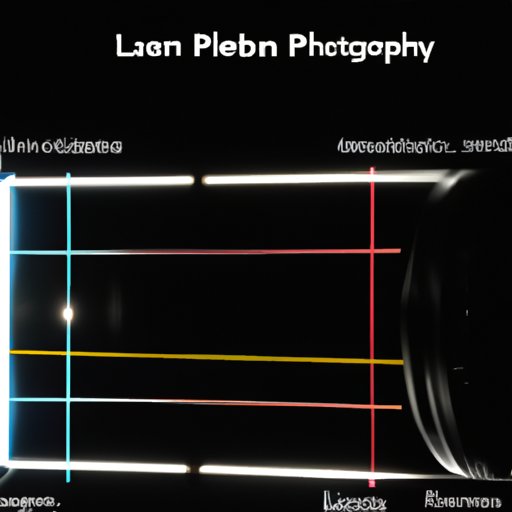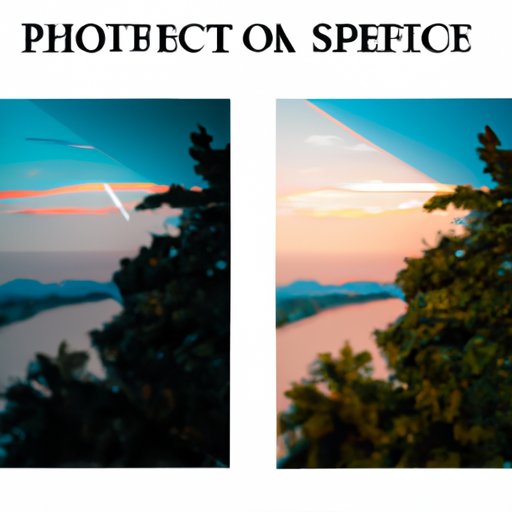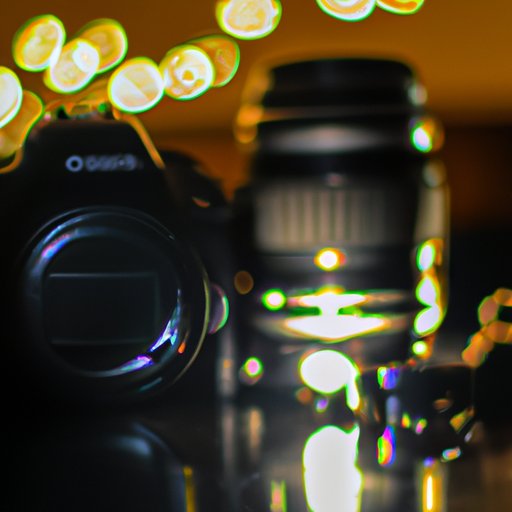Introduction
Photography is a creative art form that has been around for centuries. It involves capturing moments in time and preserving them in an image. With the advent of digital photography, it has become easier than ever to take great photos. But before you can take amazing photos, it’s important to understand the basics of photography.
Understanding the basics of photography is essential for anyone interested in taking better photographs. Whether you’re a beginner or a professional, having a solid grasp of the fundamentals will help you create stunning images. In this article, we’ll explore the basics of photography, from understanding camera components and lenses to mastering the fundamentals of lighting and composition.
Exploring the Basics of Photography: A Beginner’s Guide
Before delving into the science behind cameras, let’s start by exploring the basics of photography. By understanding the components of a camera and the different types of lenses available, you’ll be able to make informed decisions when buying equipment.
Understanding the camera and its components
The most important part of a camera is its lens. The lens is responsible for focusing light onto the camera’s sensor, which captures the image. The lens also determines the field of view, which is the area of the scene that is visible through the lens. Different lenses have different fields of view, so it’s important to select the right lens for the job.
In addition to the lens, cameras also contain other components such as the shutter, aperture, and ISO. The shutter controls how long the camera’s sensor is exposed to light. The aperture controls how much light passes through the lens. And the ISO controls how sensitive the camera’s sensor is to light. All three of these settings work together to determine the exposure of the photograph.
Different types of cameras and lenses
There are many different types of cameras and lenses available on the market today. Digital Single Lens Reflex (DSLR) cameras are the most common type of camera used by professional photographers. These cameras offer interchangeable lenses, allowing you to switch between wide angle, telephoto, and macro lenses depending on your needs. Mirrorless cameras are becoming increasingly popular due to their small size and lightweight design. Point-and-shoot cameras are a good choice for beginners, as they are easy to use and offer good image quality.
When selecting a lens, it’s important to consider the type of photography you’ll be doing. Wide angle lenses are great for landscape photography, while telephoto lenses are ideal for wildlife and sports photography. Macro lenses are perfect for close-up shots of small objects. Prime lenses are also a good choice for beginners, as they offer a fixed focal length and generally produce sharp images.
Basic photographic techniques
Once you’ve got a basic understanding of the camera and its components, it’s time to start exploring some basic photographic techniques. Learning about composition, lighting, and exposure settings will help you create stunning images. Composition is all about the placement of elements within the frame, while lighting refers to the direction and intensity of the light in the scene. Exposure settings control how much light is captured by the camera’s sensor.
It’s also important to experiment with different shooting modes. Aperture priority mode allows you to control the depth of field, while shutter priority mode gives you control over motion blur. Manual mode is great for experienced photographers who want full control over their exposure settings. Finally, don’t forget to experiment with different angles and perspectives to add interest to your photos.

The Science Behind Cameras and How They Capture Light
Now that we’ve explored the basics of photography, let’s dive into the science behind cameras and how they capture light. To understand how cameras work, we need to look at the physics of light and how it affects a photograph.
The physics of light and how it affects a photograph
Light is made up of electromagnetic waves that travel in straight lines. When these waves hit an object, they are either absorbed, reflected, or scattered. The amount of light that is reflected off an object depends on its color and texture. The more light that is reflected, the brighter the object will appear in the photograph.
The intensity of the light also affects how an object appears in a photograph. If there is too much light, the image will be overexposed; if there is not enough light, the image will be underexposed. The direction of the light also plays an important role. Direct light creates harsh shadows, while indirect light creates softer shadows.
The mechanics of a camera
A camera works by capturing light and converting it into an electrical signal. This signal is then processed by the camera’s image processor, which produces the final image. The image processor also adjusts the exposure settings to ensure the correct amount of light is captured.
Most cameras also have an autofocus system that uses contrast detection to determine the sharpest point in the scene. This helps the camera focus on the desired subject automatically. Modern cameras also have built-in image stabilization systems that reduce camera shake and allow you to take sharper images.
Understanding exposure settings
Exposure settings control how much light is captured by the camera’s sensor. The three main exposure settings are shutter speed, aperture, and ISO. Shutter speed controls how long the camera’s sensor is exposed to light, while aperture controls how much light passes through the lens. ISO controls how sensitive the camera’s sensor is to light.
By adjusting these settings, you can control the brightness of the image. For example, a slow shutter speed and large aperture will result in a bright image, while a fast shutter speed and small aperture will result in a darker image. It’s important to experiment with different combinations of settings to get the desired effect.
Understanding the Different Types of Cameras and Lenses
As mentioned earlier, there are many different types of cameras and lenses available on the market today. Let’s take a closer look at some of the most popular options.
DSLR cameras
Digital Single Lens Reflex (DSLR) cameras are the most popular type of camera used by professional photographers. These cameras offer interchangeable lenses, allowing you to switch between wide angle, telephoto, and macro lenses depending on your needs. DSLR cameras are also capable of capturing high-quality images and videos, making them a great choice for both amateur and professional photographers.
Mirrorless cameras
Mirrorless cameras are becoming increasingly popular due to their small size and lightweight design. These cameras have the same features and capabilities as DSLR cameras but without the bulk. They are a great choice for travel photography, as they are compact and easy to carry.
Point-and-shoot cameras
If you’re just starting out in photography, a point-and-shoot camera is a good choice. These cameras are usually smaller and cheaper than DSLR cameras, and they offer good image quality. Point-and-shoot cameras are also easy to use, making them a great option for beginners.
Different types of lenses
In addition to different types of cameras, there are also many different types of lenses available. Wide angle lenses are great for landscape photography, while telephoto lenses are ideal for wildlife and sports photography. Macro lenses are perfect for close-up shots of small objects. Prime lenses are also a good choice for beginners, as they offer a fixed focal length and generally produce sharp images.

Exploring the Fundamentals of Lighting and Composition for Better Photos
Now that you’ve got a basic understanding of cameras and lenses, it’s time to explore the fundamentals of lighting and composition. Mastering these techniques will help you take better photos.
Principles of photographic composition
Composition is an important aspect of photography. It involves the placement of elements within the frame to create a pleasing image. Some of the most commonly used compositional techniques include the rule of thirds, leading lines, and framing. By using these techniques, you can create dynamic and interesting images.
Different lighting techniques
Lighting is another important element of photography. Different lighting techniques can be used to create unique effects. Natural light is often the best choice for outdoor photography, while artificial light can be used indoors. Other techniques such as backlighting, sidelighting, and fill lighting can also be used to create dramatic images.
Using natural light in photography
Natural light is often the best choice for outdoor photography. It’s free, plentiful, and easy to work with. To make the most of natural light, try shooting during the golden hours – the hour after sunrise and the hour before sunset. This is when the light is soft and warm, creating beautiful photos.

Editing Techniques to Enhance Your Photographs
Once you’ve taken your photos, you may want to edit them to enhance the colors, contrast, and sharpness. There are many photo editing software programs available, such as Adobe Photoshop, Lightroom, and GIMP. These programs allow you to adjust the exposure settings, crop the image, and apply filters and effects.
Overview of photo editing software
Photo editing software can be used to adjust the exposure settings, crop the image, and apply filters and effects. It can also be used to color correct, retouch, and sharpen the image. Most photo editing programs also have layers and masks, which allow you to make selective adjustments to the image.
Color correction and manipulation
Color correction is an important step in the editing process. It involves adjusting the hue, saturation, and brightness of the image to achieve the desired look. Color manipulation is also possible, allowing you to change the colors of specific objects in the image.
Image retouching and enhancement
Image retouching is the process of removing blemishes, smoothing skin, and enhancing details. This can be done manually or with photo editing software. Image enhancement is also possible, allowing you to adjust the contrast, sharpness, and vibrancy of the image.
Conclusion
Photography is a creative art form that requires a solid understanding of the basics. From understanding camera components and lenses to mastering the fundamentals of lighting and composition, learning the basics of photography is essential for taking better photos. Photo editing software can also be used to enhance the colors and details of an image. With practice and dedication, anyone can become a great photographer.
We hope this article has given you a better understanding of how photography works and the basics of taking great photos. If you’re looking to learn more, we recommend taking a photography course or reading books on the subject. With the right knowledge and tools, you’ll be able to take stunning photographs.
(Note: Is this article not meeting your expectations? Do you have knowledge or insights to share? Unlock new opportunities and expand your reach by joining our authors team. Click Registration to join us and share your expertise with our readers.)
